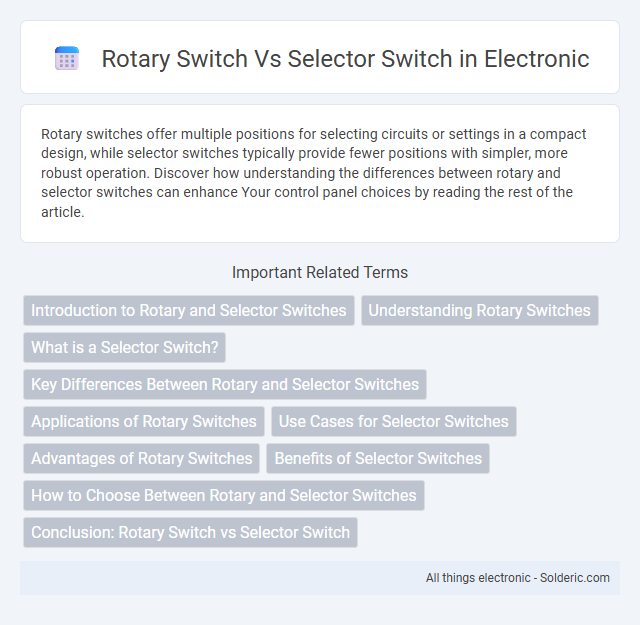Rotary switches offer multiple positions for selecting circuits or settings in a compact design, while selector switches typically provide fewer positions with simpler, more robust operation. Discover how understanding the differences between rotary and selector switches can enhance Your control panel choices by reading the rest of the article.
Comparison Table
| Feature | Rotary Switch | Selector Switch |
|---|---|---|
| Definition | A switch operated by rotating a knob or dial to select electrical circuits. | A switch that selects circuit paths using a lever or knob, often with fewer positions. |
| Number of Positions | Multiple positions (commonly 2 to 12 or more). | Typically fewer positions (usually 2 to 4). |
| Application | Used for complex control and multi-circuit selection. | Common in simple on/off or mode selection tasks. |
| Operation | Rotating mechanism with detents for precise position. | Lever or knob toggled or rotated with defined stops. |
| Durability | Designed for repetitive, long-term use in industrial contexts. | Suitable for general-purpose or occasional use. |
| Cost | Generally higher due to complexity and number of contacts. | Usually cost-effective and simpler in construction. |
Introduction to Rotary and Selector Switches
Rotary switches and selector switches serve distinct functions in controlling electrical circuits by allowing users to select different settings or modes. A rotary switch operates through a rotating knob to connect one of several terminals, ideal for applications requiring multiple circuit selections within a compact design. Selector switches often feature a lever or push-button mechanism for toggling between positions, offering intuitive and quick adjustments for your control panels or machinery.
Understanding Rotary Switches
Rotary switches allow you to select one of many electrical circuits by rotating a knob to different positions, making them ideal for multi-position control applications. Unlike selector switches, which typically have fewer fixed positions and simpler on/off functions, rotary switches provide greater flexibility with multiple contacts and complex circuit configurations. Understanding rotary switches helps ensure precise control in devices such as audio equipment, industrial machinery, and instrumentation panels.
What is a Selector Switch?
A selector switch is an electrical control device used to select between multiple circuit options or functions within a system, commonly found in industrial control panels. It typically features a knob or lever that rotates or toggles to different positions, enabling users to change operational modes or activate specific circuits. Selector switches provide clear, reliable manual control for switching applications such as motor control, machine operation, and system configuration.
Key Differences Between Rotary and Selector Switches
Rotary switches feature a rotating actuator that allows multiple circuit positions, ideal for selecting various electrical paths within a single device. Selector switches typically use a lever or toggle mechanism for simpler on/off or multi-position controls, mostly found in control panels and machinery operation. Key differences include the rotary switch's ability to handle more positions compactly and the selector switch's straightforward design for quick, reliable switching.
Applications of Rotary Switches
Rotary switches are widely used in applications requiring multiple circuit selections, such as in audio and video equipment, industrial control panels, and communication devices. Their ability to handle high current loads and provide reliable, precise switching makes them ideal for selecting different voltage levels or input sources. Choosing a rotary switch can enhance your equipment's versatility and operational control in complex electrical systems.
Use Cases for Selector Switches
Selector switches are commonly used in industrial control panels to enable operators to choose specific machine functions or operational modes, such as start, stop, or reset. Their design allows easy toggling between multiple options, making them ideal for applications requiring clear and deliberate user inputs. Your control system benefits from selector switches when precise, manual selection among predefined settings is essential for safe and efficient operation.
Advantages of Rotary Switches
Rotary switches offer precise control with multiple positions, making them ideal for complex electrical circuits where selecting different functions or settings is necessary. Their compact design allows space-saving installations while providing reliable mechanical operation and durability under frequent use. You benefit from enhanced user interface flexibility, ensuring accurate and repeatable selections compared to simpler switch types.
Benefits of Selector Switches
Selector switches offer precise position indication and quick switching between multiple circuit options, enhancing control panel efficiency. Their compact design allows integration into confined spaces while providing reliable electrical contact and durability. Commonly used in industrial automation, selector switches improve operator ergonomics and reduce maintenance costs compared to rotary switches.
How to Choose Between Rotary and Selector Switches
Choosing between rotary and selector switches depends on the application's operational needs and user interface preferences. Rotary switches offer multiple position selections allowing for more complex control in compact spaces, ideal for settings requiring sequential or multi-step processes. Selector switches provide quick, distinct on/off or mode selection with a simple toggle, making your choice efficient for straightforward, rapid switching tasks.
Conclusion: Rotary Switch vs Selector Switch
Rotary switches provide multiple positions and precise control ideal for applications requiring varied circuit configurations, while selector switches offer simple, reliable on/off or mode selection with easy operation. Rotary switches are suited for complex control panels needing multiple outputs, whereas selector switches excel in straightforward switching tasks. Choosing between them depends on the complexity of the control requirement and ease of use desired in the application.
rotary switch vs selector switch Infographic

 solderic.com
solderic.com